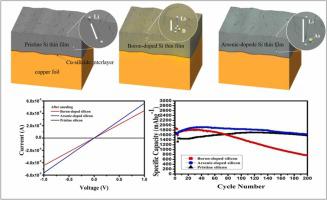Nano Energy ( IF 16.8 ) Pub Date : 2022-08-08 , DOI: 10.1016/j.nanoen.2022.107688 Yin-Wei Cheng , Chun-Hung Chen , Shih-An Wang , Yi-Chang Li , Bo-Liang Peng , Jun-Han Huang , Chuan-Pu Liu

|
Although pristine silicon (Si) has been employed as a high-capacity anode material, high performance of Si-based lithium-ion battery (LIB) still remains challenging constrained mainly by low intrinsic electrical conductivity of the semiconductor. This drawback can be addressed by doping Si with group III and V elements; nevertheless, a systematic study on the doping species is rarely reported. Herein, the effects of dopants (boron and arsenic) in Si thin film anodes, prepared by electron beam evaporation from different target materials (including pristine, p-type, and n-type Si), on the performance of LIB are investigated. In a coin cell configuration, the doped Si films are inferior to the pristine counterparts in terms of irreversible capacity loss at the first circle, possibly due to incorporation of more lithium ions with a higher conductivity in the former. Intriguingly, boron and arsenic ions are demonstrated as regulating dopants that can deteriorate (for the former) or enhance (for the latter) the capacity retention and rate capabilities of the pristine Si-based LIBs. Electrochemical impedance spectroscopy and microstructure characterizations reveal that the high electrical conductivity and chemical reactivity of boron ions with electrolytes aggravate the formation and propagation of cracks into the depth during cycling and thicken the thickness of solid electrode interphase, consequently increasing charge transfer impedance. This study clarifies the working mechanisms of different doping species in the Si thin film anodes in response to electrochemical cycling and shed light on the improved performance of thin film based LIBs with appropriate dopants.
中文翻译:

适当掺杂剂对硅薄膜锂离子电池的推进性能
尽管原始硅 (Si) 已被用作高容量阳极材料,但硅基锂离子电池 (LIB) 的高性能仍然具有挑战性,主要受限于半导体的低本征电导率。这个缺点可以通过在 Si 中掺杂 III 族和 V 族元素来解决。然而,很少有关于兴奋剂种类的系统研究报道。在此,研究了通过电子束蒸发从不同靶材(包括原始、p 型和 n 型 Si)制备的 Si 薄膜阳极中掺杂剂(硼和砷)对 LIB 性能的影响。在纽扣电池配置中,掺杂的硅薄膜在第一圈的不可逆容量损失方面不如原始对应物,可能是由于在前者中掺入了更多具有更高电导率的锂离子。有趣的是,硼和砷离子被证明是调节掺杂剂,它们会降低(对于前者)或增强(对于后者)原始硅基 LIB 的容量保持率和倍率能力。电化学阻抗谱和微观结构表征表明,硼离子与电解质的高电导率和化学反应性在循环过程中加剧了裂纹的形成和向深处扩展,并加厚了固体电极界面的厚度,从而增加了电荷转移阻抗。











































 京公网安备 11010802027423号
京公网安备 11010802027423号